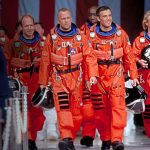Contact (1997)
- movie news
- August 27, 2024

“Contact” (1997) is a thought-provoking science fiction film directed by Robert Zemeckis, based on the 1985 novel of the same name by Carl Sagan. The film, which reflects Sagan’s deep fascination with space and the potential for extraterrestrial life, was adapted by Sagan and his wife, Ann Druyan, who contributed to the story’s conceptualization. “Contact” stars Jodie Foster, Matthew McConaughey, Tom Skerritt, and James Woods, and it explores profound themes about humanity’s place in the universe, science, faith, and the search for meaning.
The film’s narrative centers on Dr. Ellie Arroway (played by Jodie Foster), an astrophysicist and radio astronomer who is dedicated to the search for extraterrestrial intelligence (SETI). Ellie’s work involves scanning the cosmos for signals that might indicate the presence of alien civilizations. Her life changes dramatically when she and her team detect a mysterious signal emanating from the Vega star system, which, upon further analysis, reveals the blueprint for constructing a machine capable of interstellar travel. The discovery of this signal propels Ellie into a journey that challenges her scientific beliefs and personal convictions.
Jodie Foster’s portrayal of Dr. Ellie Arroway is central to the film’s success. Foster delivers a nuanced performance that captures Ellie’s intellectual curiosity, determination, and emotional vulnerability. As a character who has dedicated her life to the pursuit of knowledge and proof of extraterrestrial life, Ellie embodies the film’s central themes of exploration and the quest for truth. Her journey from skepticism to awe and her struggle to reconcile scientific evidence with the personal and philosophical implications of her discoveries are portrayed with depth and sensitivity.
Matthew McConaughey plays Palmer Joss, a religious scholar and theologian who becomes romantically involved with Ellie. McConaughey’s performance adds a layer of emotional complexity and intellectual contrast to the film. Palmer’s character represents faith and spirituality, providing a counterpoint to Ellie’s scientific rationality. The dynamic between Ellie and Palmer highlights the film’s exploration of the intersection between science and religion, and their interactions serve to deepen the thematic exploration of belief and understanding.
Tom Skerritt and James Woods provide strong supporting performances as characters who play crucial roles in the unfolding events. Skerritt portrays David Drumlin, a government official who initially doubts the validity of Ellie’s discovery but later becomes a significant figure in the process of making the contact with extraterrestrials. Woods plays Michael Kitz, a government official with a more skeptical and strategic approach, adding tension and complexity to the narrative.

Robert Zemeckis, known for his diverse range of films, brings his expertise in storytelling and visual effects to “Contact.” The film’s direction is marked by its careful balance of scientific concepts and emotional depth. Zemeckis creates a narrative that is both intellectually stimulating and deeply affecting, exploring the implications of first contact with an alien civilization. The film’s pacing and structure are designed to build suspense and anticipation while also allowing for moments of introspection and philosophical reflection.
The screenplay, adapted by James V. Hart and Michael Goldenberg from Sagan and Druyan’s outline, effectively translates the novel’s complex themes and ideas into a compelling cinematic experience. The screenplay addresses fundamental questions about humanity’s place in the universe, the nature of belief, and the potential for connection with other intelligent beings. The dialogue is thought-provoking, and the script successfully weaves together scientific discourse and personal drama.

The film’s visual effects, created by a team led by industrial light & magic, are integral to its storytelling. The depiction of the alien signal and the subsequent construction of the interstellar machine are rendered with a sense of grandeur and wonder. The visual representation of the machine’s journey through space and the encounter with the alien intelligence is both imaginative and visually striking. The effects work enhances the film’s sense of scale and the awe-inspiring nature of the discoveries being made.
Alan Silvestri’s musical score contributes significantly to the film’s emotional and thematic depth. The score’s orchestral arrangements underscore the film’s moments of wonder, tension, and introspection. Silvestri’s music complements the visual and narrative elements, enhancing the film’s ability to evoke a sense of awe and contemplation.

“Contact” also engages with philosophical and existential questions about the nature of human existence and the limits of knowledge. The film delves into the impact of discovering evidence of extraterrestrial life on human society and individual beliefs. It explores how such a discovery challenges existing worldviews and encourages a re-evaluation of humanity’s place in the cosmos. The film presents a nuanced view of science and faith, suggesting that the pursuit of knowledge and understanding can coexist with spiritual and existential inquiry.
In conclusion, “Contact” (1997) is a compelling and intellectually stimulating film that explores profound themes about science, faith, and humanity’s place in the universe. Directed by Robert Zemeckis and adapted from Carl Sagan’s novel, the film features a powerful performance by Jodie Foster, supported by a talented cast including Matthew McConaughey, Tom Skerritt, and James Woods. With its thought-provoking narrative, impressive visual effects, and evocative score, “Contact” remains a significant contribution to the science fiction genre, offering a profound exploration of the quest for knowledge and the potential for connection with extraterrestrial intelligence.










